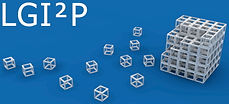
Lab. LGI2P



وزارة التعليم العالي والبحث العلمي - العراق
الجامعة التقنية الشمالية
الدكتور حسن كريم عبد الرحمن
اختصاص معالجة الصور الرقمية وامنية المعلومات
Steganography and Steganalysis
Since long time, steganography techniques are known and widely used. Steganography is a technique to hide a secret message in a digital media and communicate secretly. In modern-day digital steganography works by modifying bits within various digital media files (for example images, videos, audio's) to avoid the detection of the secret message.
In reality, the steganography can be used for legal and illegal purpose, but in recently it has received a great attention from national security seasons.
On the other hand, detecting steganography methods belongs to the field of steganalysis. This field is constantly evolving its techniques, methods and theories in parallel line with the development of steganography techniques, to detect hidden messages.
In 1983, Simmons' proposed the first formulation of the steganography for secret (straightforward) communication. Three characters are necessary to explain this formulation, Alice and Bob two criminal imprisoned in separate cells, far at distance from each other. They can communicate together and they know that this communication is monitored by Eve, the prison warden. They decide to put an escape plan from jail and communicate by covered their messages without getting noticed by Eve.
Indeed, if Eve notice about the secret messages, she can decide to
remove communication, therefore the escape plan will fail.
The figure ( 1 ) illustrate the general model for the Simmons’ prisoners’ problem.

Figure 1. The general model for Simmons' "prisoners problem".
Proposed new digital color image steganalysis approches
In my PhD. research, for the part of security domain, I identified and analyzed the links between the detectability map, the cost function, and the strategies in a game theory context. Also, I studied different models of steganography and steganalysis, strategies, security functions, values of detectability, etc, based on Game Theory.
Furthermore, I proposed three new approaches deals with color image steganalysis based on machain learing. The efficiency of the proposed approaches are demonstrated on three stenographic algorithms designed to hide messages in images:
- S-UNIWARD steganography method
- WOW steganography method
- Synch-HILL steganography method.
Each steganography method is tested using different payload sizes ( 0.01, 0.05, 0.1, 0.2. 0.3, 0.4 and 0.5) bpc.
The three proposed approaches are compared to latest and famous color image steganalysis methods based on computation features and Ensemble Classifier classification:
- The Spatial Color Rich Model (CRM).
- The CFA-aware Rich Model (CFARM).
Experimental results show that fusing proposed features with those obtained by Color Rich Model allows in the majority of cases, the detectability of hidden messages in the color images.
Additionally, the our approach achieved higher detection rates than the recent steganalysis approaches: CRM, CFARM.
Proposed new method named:
(Stego4FB) color image steganography method for Facebook
will be published soon 2024.
Abstract:
In this paper, we proposed steganography cover selection method named Stego4FB, based an adaptive Discrete Cosine Transform (DCT) for the color image steganography method. This adaptation is based on the standard deviation of the DCT coefficients in each block, and manipulates the DCT coefficients of the image to embed hidden massages in the Joint Photographic Experts Group JPEG format. In addition, we proved that Facebook is the best place for secret communication. By using three steganography applications to hide the messages into JPEG color images, all the messages were completely received by the other side at Facebook.
Experiments demonstrate the proposed method makes it difficult to detect and destroy hidden messages on Facebook using a JPEG color image size of 512$x$512, . All the Python source codes involved in this work will be available for researchers soon:
- Python Codes Stego4FB steganography method link <---------
- Codes Compute (AES-128) encryption and decryption - link <---------
- Codes Embedding message - link <---------
- Codes Extracting message - link <---------
- Codes Image Compression Technique - link <---------
- Python code for Subsampling Technique - link <---------
- Codes Compute PSNR - link <---------
- Codes Compute SIMM - link <----------
- Codes Compute FSIM - link <---------

